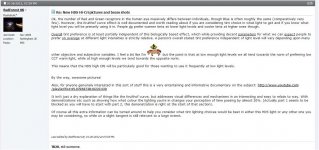From an anatomical standpoint, why do some individuals see significant CA in a particular binocular while others look through the same binocular and see none ?
For me it is visible in all optics, in varying degrees of severity. I had no problem seeing it in the outer edges of the Caldera even though they have ED glass. I asked both Roger Cox and John Dracon if they saw CA in their Minox Porro's. They don't, but I see quite a bit in mine. I've included image files of their statements.
Thanks Bruce
Going back to the OP, "seeing CA" is almost universally accepted as the
perception of lateral color or color fringing. It is a symptom of the aberration, but not exactly a direct measure of the aberration itself. There are other symptoms as well, such as image deterioration that leads to degraded visual acuity (perceived sharpness). These perceptions, however, are also influenced by viewing conditions, as well as what the observer expects or demands of an instrument based on prior experience. The latter might be thought of as the individual's
tolerance for CA, which often increases when an external object of interest captures attention, but decrease when the instrument itself is examined. An unpredictable human foible.
From an anatomical standpoint (an interesting choice of words) it comes down to how an individual's
visual system processes information. The eye is in fact an anatomical extension of the brain, not separate from it as many people believe. So, anatomically, the visual system is really (eye + brain).
The perception of color fringes is arguably affected by both illumination and transmission. It is self-evident that fringing is not visible under narrow-band monochromatic lighting conditions, even when massive CA may be part of the instrument's optical design. When viewed monochromatically one can not even see a spectral band from a prism.
Although much more complex and poorly understood, lens coatings must also influence fringe perception due to the characteristics of the luminous intensity distribution presented to the eyes. Historically, it seems pretty compelling to me that by increasing the efficiency of multicoatings (i.e., creating flatter transmission curves), CA awareness was inevitably introduced to the population because of annoying fringe perceptions. This, I would argue, helps to explain why older instruments, of essentially the same design, seem to be better controlled for CA. Ironically, it is as if master opticians of the past were replaced by modern dolts.
It wouldn't be the first time, however, that a technological advance in one area has created collateral issues to be overcome by progress in another. In this instance, I would argue, the routine use of ED glass finally became necessary to control the underlying cause: optical CA inherent in the design that in earlier times was less conspicuous and, hence, acceptable.
Just my take on the situation, of course, which captures a lot of what was said previously and is not intended to be confrontational. In this arena I think we are much like the proverbial blind men describing an elephant.
Ed






